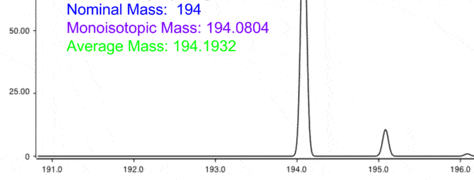Fine-Tune Your MALDI-TOF to Produce Good-looking Mass Spectra

Mass Spec is all about getting the perfect peaks. Without a good peak assigning the correct mass is impossible and you cannot make accurate identifications. Make sure you know how to adjust your MALDI-TOF instrument parameters to achieve your perfect peak.
In our previous posts ‘How does Mass Spec Work’ and ‘Imaging Mass Spectrometry: the new(ish) kid on the block’, provide Mass Spec newbies with an excellent introduction to mass spectrometry. We’ve also covered how to select the best matrix and prep your sample, for MALDI (Matrix-Assisted Laser Desorption/Ionization) experiments, in ‘How to Choose Your MALDI (Soul) Matrix. However, once your sample is prepped, there are still many parameters you can tweak in your MALDI-TOF (time-of-flight) machine to make sure you acquire high-quality data.
What does a good mass spectrum look like?
Below you can see a continuum or analogous spectrum. In which the full profile of each ion peak is shown. Average mass is usually calculated by chemists for each element by weighting for its natural isotopic abundance. The monoisotopic mass, however, is calculated based on the most abundantly detected isotope of each element. While the nominal mass is the same value rounded to the nearest integer.
A high-quality mass spectrum, like the one in the above image, will have a high signal-to-noise ratio (s/n), allowing significant mass peaks to be clearly labeled and isotope clusters to be fully resolved. Each machine usually has its own optimum peak shape, but a smooth peak, without any spikes or shoulders is essential. Machines with TOF analyzers tend to produce more asymmetric peaks, but care should be taken to minimize this asymmetry.
Why do you need high-quality spectra?
An accurate peak centroid is critical for the correct mass assignment. This enables sample identification. It is also important to produce reproducible peaks. Further, poor peak shapes can lead to problems with sensitivity and mass resolution, i.e. how easily you can separate ions of two different m/z values.
So, what parameters can you tweak in your MALDI-TOF machine?
There are a number of MALDI-TOF instrument parameters that can be adjusted to make sure you acquire good-looking mass spectra. These include:
Laser power
The laser power is a measure of how much energy is delivered per unit area sampled. Increasing the laser power, beyond the threshold needed to detect ion signals with sufficient s/n, can increase the analyte signal intensity. However, the optimum laser power must be determined as one that is too high can cause the signal to become saturated, leading to an incorrect peak shape.
Laser beam diameter
Newer MALDI-TOF machines are equipped with tunable lasers. This means that the diameter of the laser beam can be adjusted. A larger diameter increases the intensity of analyte ion signals as more of the sample is ionised. Since the size of the ablated area at each point determines the effective spatial resolution however, narrower beams are used for high-resolution imaging mass spectrometry. If a narrow beam is being used, the laser power will have to be adjusted accordingly to ensure that the fewer molecules being sampled are all being ionised.
Number of laser shots
The number of ions that have to be desorbed and ionised to form a detectable analyte ion signal is known as the limit of detection (LOD) of the instrument. Averaging the signal from multiple laser shots allows more ions to reach the instrument’s LOD, improving the intensity of analyte signals. Typically about 50-100 laser shots are averaged to acquire a spectrum at each sampling spot.
Pulse delay
The delayed extraction is the time between the laser pulse ionising the sample and the application of the full accelerating voltage to the ions. Increasing the delayed extraction allows ions with lesser initial kinetic energy to travel for longer in the electric field, allowing it to pick up as much kinetic energy as other ions of the same mass when the full accelerating voltage is applied. As all the ions of the same mass now have the same kinetic energy they will arrive at the detector at the same time producing a sharp peak (i.e. greater resolution) in the mass spectrum. Typically, the delayed extraction is set between 120-400 ns
Grid voltage
The grid voltage is the percentage of accelerating voltage that is applied to a variable-voltage grid over the sample plate. Generally, a higher grid voltage with a lower potential difference decreases ion fragmentation. It is often adjusted in conjunction with the delayed extraction to optimise the quality of the spectrum.
Each of these parameters can be optimised to ensure that you collect high-quality data from your MALDI experiment. Published work is often a good start when determining which parameters to use. And your particular MALDI-TOF vendor is another helpful ally in your quest for good-looking spectra!
—
Sources:
- Barwick, V., Langley, J., Mallet, T., Stein, B., Webb, K. (2006). Best practice guide for generation mass spectra. LGC Ltd.
- Chaurand, P., Schriver, K.E., Caprioli, R.M. (2007). Instrument design and characterization for high resolution MALDI?MS imaging of tissue sections. Journal of Mass Spectrometry 42(4): 476-489.
- Rubakhin, S. S. and Sweedler, J. V. (2010). A mass spectrometry primer for mass spectrometry imaging. Mass Spectrometry Imaging: Principles and Protocols: 21-49.
- Watson, J. T. and Sparkman, O. D. (2007). Introduction to mass spectrometry: instrumentation, applications, and strategies for data interpretation, John
1 Comments
Leave a Comment
You must be logged in to post a comment.

Hi, Lakshini Mendis
Great introduction.
May I ask you a question: Why a higher grid voltage with a lower potential difference will decreases ion fragmentation? Do you have any references to explain it.
Thank you very much.